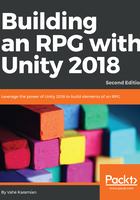
Contest tree
The intent of a contest tree is to provide a mechanical means to create rising tension within a game. This is also known as Escalating Conflict.
Contest trees are high-level conflict resolution systems made up of many levels of contests arranged in a hierarchical fashion. The way they work is that lower-level contests feed into the higher-level contests and hence affect the outcome of the higher-level contests.
In other words, the higher-level contest could be to kill the big boss, but before you get to the big boss, there could be other mini battles that you will have to complete, and the outcome of the mini-battles will drive the outcome of the big battle. A simple example would be the amount of experience points you have gained before reaching the main boss.
Since the higher-level contests are somehow related to the lower-level contests, players do pay attention to the outcome of the lower-level contests; therefore, tensions arise concerning the eventual success or failure of a higher-level contest as a lower-level contest succeeds or fails.
It is best to use a contest tree when you want to create a sense of rising tension in your game. This can be achieved by applying different mechanics as the player progresses through the levels. Creating suspense in a cRPG is very simple, as you have a lot of control over the way levels and game play are designed. Since we have the ability to create our 3D worlds as we like, it would be easy to incorporate suspense into the game.
A few key points for creating tension in your game are as follows:
- The hero and enemy should be evenly matched.
- The hero and enemy should both periodically fail in their attempts, providing they are worthy adversaries.
- The hero and enemy's successes and failures are never so great that all hope of success of attaining the high-level goals is eliminated from either side.
- A highlight concerning contest trees is that it can only resolve high-level conflicts dealing with the mechanical inputs by the system. That is, if Damage and Remaining Hit Points are the only gauges used as an input into a conflict resolution, then the mechanics can only resolve issues dealing with Damage and Hit Points. To design a flexible contest tree, you will need to consider both the inputs as well as the outputs.